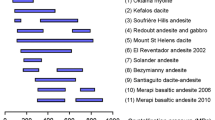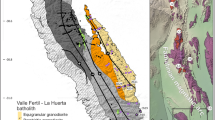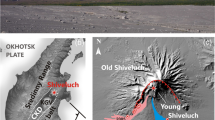Abstract
Volcanoes at subduction zones reside above complex magma plumbing systems, where individual magmatic components may originate and interact at a range of pressures. Because whole-rock compositions of subduction zone magmas are the integrated result of processes operating throughout the entire plumbing system, processes such as mixing, homogenisation and magma assembly during shallow storage can overprint the chemical signatures of deeper crustal processes. Whereas melt inclusions provide an effective way to study the uppermost 10–15 km of the plumbing system, challenges remain in understanding magma intrusion, fractionation and hybridisation processes in the middle to lower crust (15–30 km depth), which commonly involves amphibole crystallisation. Here, we present new insights into the mid-crustal plumbing system at Mount St. Helens, USA, using multiple regression methods to calculate trace element partition coefficients for amphibole phenocrysts, and thus infer the trace element compositions of their equilibrium melts. The results indicate vertically distributed crystal fractionation, dominated by amphibole at higher pressures and in intermediate melts, and by plagioclase at lower pressures. Variations in Nb, Zr and REE concentrations at intermediate SiO2 contents suggest repeated scavenging of partially remelted intrusive material in the mid-crust, and mixing with material from geochemically diverse sources. Amphibole is an effective probe for deep crustal magmatism worldwide, and this approach offers a new tool to explore the structure and chemistry of arc magmas, including those forming plutonic or cumulate materials that offer no other constraints on melt composition.







Similar content being viewed by others
References
Adam J, Green TH (1994) The effects of pressure and temperature on the partitioning of Ti, Sr and REE between amphibole, clinopyroxene and basanitic melts. Chem Geol 117:219–233
Adam J, Green T (2006) Trace element partitioning between mica- and amphibole-bearing garnet lherzolite and hydrous basanitic melt: 1. Experimental results and the investigation of controls on partitioning behaviour. Contrib Mineral Petrol 152:1–17
Adam J, Green TH, Sie SH (1993) Proton microprobe determined partitioning of Rb, Sr, Ba, Y, Zr, Nb and Ta between experimentally produced amphiboles and silicate melts with variable F content. Chem Geol 109:29–49
Alonso-Perez R, Müntener O, Ulmer P (2009) Igneous garnet and amphibole fractionation in the roots of island arcs: experimental constraints on andesitic liquids. Contrib Mineral Petrol 157:541. https://doi.org/10.1007/s00410-008-0351-8 doi
Bacon CR, Bruggman PE, Christiansen RL et al (1997) Primitive magmas at five Cascades volcanic fields: melts from hot, heterogeneous sub-arc mantle. Can Mineral 35:397–423
Berlo K, Blundy J, Turner S, Hawkesworth C (2007) Textural and chemical variation in plagioclase phenocrysts from the 1980 eruptions of Mount St. Helens, USA. Contrib Mineral Petrol 154:291–308. https://doi.org/10.1007/s00410-007-0194-8
Blatter DL, Sisson TW, Hankins WB (2017) Voluminous arc dacites as amphibole reaction-boundary liquids. Contrib Mineral Petrol 172:27:27. https://doi.org/10.1007/s00410-017-1340-6
Blundy J, Cashman K (2001) Ascent-driven crystallisation of dacite magmas at Mount St Helens, 1980–1986. Contrib Mineral Petrol 140:631–650. https://doi.org/10.1007/s004100000219
Blundy J, Cashman K (2005) Rapid decompression-driven crystallization recorded by melt inclusions from Mount St. Helens volcano. Geology 33:793–796
Blundy J, Cashman KV, Berlo K (2008) Evolving magma storage conditions beneath Mount St. Helens inferred from chemical variations in melt inclusions from the 1980–1986 and current (2004–2005) eruptions. In: Sherrod DR, Scott WE, Stauffer PH (eds) A volcano rekindled: the renewed eruption of Mount St. Helens, 2004–2006. U.S. Geological Survey Professional Paper 1750, pp 755–790
Brenan JM, Shaw HF, Ryerson FJ, Phinney DL (1995) Experimental determination of trace-element partitioning between pargasite and a synthetic hydrous andesitic melt. Earth Planet Sci Lett 135:1–11
Cashman K, Blundy J (2013) Petrological cannibalism: the chemical and textural consequences of incremental magma body growth. Contrib Mineral Petrol 166:703–729. https://doi.org/10.1007/s00410-013-0895-0
Cashman KV, McConnell S (2005) Multiple levels of magma storage during the 1980 summer eruptions of Mount St. Helens, WA. Bull Volcanol 68:57–75
Claiborne LL, Miller CF, Flanagan DM et al (2010) Zircon reveals protracted magma storage and recycling beneath Mount St. Helens. Geology 38:1011–1014
Clynne MA, Calvert AT, Wolfe EW et al (2008) The Pleistocene eruptive history of Mount St. Helens, Washington, from 300,000 to 12,800 years before present. In: Sherrod DR, Scott WE, Stauffer PH (eds) A volcano rekindled: the renewed eruption of Mount St. Helens. U.S. Geological Survey Professional Paper 1750, pp 2004–2006
Cooper KM, Reid MR (2003) Re-examination of crystal ages in recent Mount St. Helens lavas: implications for magma reservoir processes. Earth Planet Sci Lett 213:149–167
Crummy JM, Savov IP, Navarro-Ochoa C et al (2014) High-K Mafic Plinian eruptions of Volcan de Colima, Mexico. J Petrol 55:2155–2192. https://doi.org/10.1093/petrology/egu053
Dalpé C, Baker DR (2000) Experimental investigation of large-ion-lithophile-element-, high-field-strength-element- and rare-earth-element-partitioning between calcic amphibole and basaltic melt: the effects of pressure and oxygen fugacity. Contrib Mineral Petrol 140:233–250
Davidson J, Turner S, Handley H et al (2007) Amphibole “sponge” in arc crust? Geology 35:787–790
DeBari SM, Greene AR (2011) Vertical stratification of composition, density, and inferred magmatic processes in exposed arc crustal sections. In: Brown D, Ryan PD (eds) Arc-continent collision. Springer, Berlin, pp 121–144
Dyar MD, Breves EA, Gunter ME et al (2016) Use of multivariate analysis for synchrotron micro-XANES analysis of iron valence state in amphiboles. Am Mineral 101:1171–1189
Eggler DH (1972) Amphibole stability in H2O-undersaturated calc-alkaline melts. Earth Planet Sci Lett 15:28–34
Flinders AF, Shen Y (2017) Seismic evidence for a possible deep crustal hot zone beneath Southwest Washington. Sci Rep 7:7400. https://doi.org/10.1038/s41598-017-07123-w
Gardner JE, Carey S, Rutherford MJ, Sigurdsson H (1995) Petrologic diversity in Mount St. Helens dacites during the last 4,000 years: implications for magma mixing. Contrib Mineral Petrol 119:224–238
Green TH, Pearson NJ (1985) Experimental determination of REE partition coefficients between amphibole and basaltic to andesitic liquids at high pressure. Geochim Cosmochim Acta 49:1465–1468
Hawthorne FC, Oberti R (2007) Amphiboles: crystal chemistry. Rev Mineral Geochem 67:1–54
Heliker C (1995) Inclusions in Mount St. Helens dacite erupted from 1980 through 1983. J Volcanol Geotherm Res 66:115–135
Hildreth W, Fierstein J (1997) Recent eruptions of Mount Adams, Washington Cascades, USA. Bull Volcanol 58:472–490
Hill GJ, Caldwell TG, Heise W et al (2009) Distribution of melt beneath Mount St Helens and Mount Adams inferred from magnetotelluric data. Nat Geosci 2:785–789
Hilyard M, Nielsen RL, Beard JS et al (2000) Experimental determination of the partitioning behaviour of rare earth and high field strength elements between pargasitic amphibole and natural silicate melts. Geochim Cosmochim Acta 64:1103–1120
Holbrook SW, Mooney WD, Christensen NI (1992) The seismic velocity structure of the deep continental crust. In: Fountain DM, Arculus R, Kay R (eds) Continental lower crust. Elsevier, Amsterdam, pp 1–43
Izbekov PE, Eichelberger JC, Patino LC et al (2002) Calcic cores of plagioclase phenocrysts in andesite from Karymsky volcano: evidence for rapid introduction by basaltic replenishment. Geology 30:799–802
Jicha BR, Hart GL, Johnson CM et al (2009) Isotopic and trace element constraints on the petrogenesis of lavas from the Mount Adams volcanic field, Washington. Contrib Mineral Petrol 157:189–207
Kiser E, Palomeras I, Levander A et al (2016) Magma reservoirs from the upper crust to the MOHO inferred from high-resolution Vp and Vs models beneath Mount St. Helens, Washington State, USA. Geology 44:411–414. https://doi.org/10.1130/G37591.1 doi
Klein M, Stosch H-G, Seck HA (1997) Partitioning of high field-strength and rare-earth elements between amphibole and quartz-dioritic to tonalitic melts: an experimental study. Chem Geol 138:257–271
Krawczynski MJ, Grove TL, Behrens H (2012) Amphibole stability in primitive arc magmas: effects of temperature, H2O content, and oxygen fugacity. Contrib Mineral Petrol 164:317–339. https://doi.org/10.1007/s00410-012-0740-x
LaTourrette T, Hervig RL, Holloway JR (1995) Trace element partitioning between amphibole, phlogopite, and basanite melt. Earth Planet Sci Lett 135:13–30
Leake BE, Woolley AR, Arps CES et al (1997) Nomenclature of amphiboles: report of the subcommittee on amphiboles of the International Mineralogical Association, Commission on New Minerals and Mineral Names. Can Mineral 35:219–246
Leeman WP, Smith DR (2018) The role of magma mixing, identification of mafic magma inputs, and structure of the underlying magmatic system at Mount St. Helens. Am Mineral 103:1925–1944
Leeman WP, Smith DR, Hildreth W et al (1990) Compositional diversity of late Cenozoic basalts in a transect across the southern Washington Cascades: implications for subduction zone magmatism. J Geophys Res 95:19561–19582
Leeman WP, Lewis JF, Evarts RC et al (2005) Petrologic constraints on the thermal structure of the cascades arc. J Volcanol Geotherm Res 140:67–105
Li L, Xiong XL, Liu XC (2017) Nb/Ta fractionation by amphibole in hydrous basaltic systems: implications for arc magma evolution and continental crust formation. J Petrol 58:3–28
Locock AJ (2014) An Excel spreadsheet to classify chemical analyses of amphiboles following the IMA 2012 recommendations. Comput Geosci 62:1–11
Loewen MW (2013) Volatile mobility of trace metals in volcanic systems. Ph.D., Oregon State University
Loewen MW, Kent AJR (2012) Sources of elemental fractionation and uncertainty during the analysis of semi-volatile metals in silicate glasses using LA-ICP-MS. J Anal At Spectrom 27:1502. https://doi.org/10.1039/c2ja30075c
Macpherson CG, Chiang KK, Hall R et al (2010) Plio-Pleistocene intra-plate magmatism from the southern Sulu Arc, Semporna peninsula, Sabah, Borneo: implications for high-Nb basalt in subduction zones. J Volcanol Geotherm Res 190:25–38
Martel C, Pichavant M, Holtz F et al (1999) Effects of fO2 and H2O on andesite phase relations between 2 and 4 kbar. J Geophys Res 104:29453–29470
Mason KR, Grant L, Furlow E (1980) The economic effects of the eruptions of Mount St. Helens. U.S. International Trade Commission publication 1096, p 84
McLeod CL, Davidson JP, Nowell GM, de Silva SL (2012) Disequilibrium melting during crustal anatexis and implications for modeling open magmatic systems. Geology 40:435–438
Melekhova E, Blundy J, Robertson R, Humphreys MCS (2015) Experimental evidence for polybaric differentiation of primitive arc basalt beneath St. Vincent, Lesser Antilles. J Petrol 56:161–192
Moore G, Carmichael ISE (1998) The hydrous phase equilibria (to 3 kbar) of an andesite and basaltic andesite from western Mexico: constraints on water content and conditions of phenocryst growth. Contrib Mineral Petrol 130:304–319
Müntener O, Ulmer P (2018) Arc crust formation and differentiation constrained by experimental petrology. Am J Sci 318:64–89
Nakamura M, Shimakita S (1998) Dissolution origin and syn-entrapment compositional change of melt inclusion in plagioclase. Earth Planet Sci Lett 161:119–133
Nandedkar RH, Hürlimann N, Ulmer P, Müntener O (2016) Amphibole-melt trace element partitioning of fractionating calc-alkaline magmas in the lower crust: an experimental study. Contrib Mineral Petrol 171:71. https://doi.org/10.1007/s00410-016-1278-0
Nelson ST, Montana A (1992) Sieve-textured plagioclase in volcanic rocks produced by rapid decompression. Am Mineral 77:1242–1249
Nicholls IA, Harris KL (1980) Experimental rare earth element partition coefficients for garnet, clinopyroxene and amphibole coexisting with andesitic and basaltic liquids. Geochim Cosmochim Acta 44:287–308
Nichols ML, Malone SD, Moran SC et al (2011) Deep long-period earthquakes beneath Washington and Oregon volcanoes. J Volcanol Geotherm Res 200:116–128
Pallister JS, Thornber CR, Cashman KV et al (2008) Petrology of the 2004–2005 Mount St. Helens lava dome—implications for magmatic plumbing and eruption triggering. In: Sherrod DR, Scott WE, Stauffer PH (eds) A volcano rekindled: the renewed eruption of Mount St. Helens, 2004–2006. U.S. Geological Survey Professional Paper 1750, pp 647–702
Pallister, J.S., Clynne, M.A., Wright, H.M., Van Eaton, A.R., Vallance, J.W., Sherrod, D.R., and Kokelaar, B.P., 2017, Field-trip guide to Mount St. Helens, Washington—an overview of the eruptive history and petrology, tephra deposits, 1980 pyroclastic density current deposits, and the crater. U.S. Geological Survey Scientific Investigations Report, vol 2017–5022–D, p 65. https://doi.org/10.3133/sir20175022D
Pritchard ME, Gregg PM (2016) Geophysical evidence for silicic crustal melt in the continents: where, what kind, and how much? Elements 12:121–127. https://doi.org/10.2113/gselements.12.2.121
Prouteau G, Scaillet B (2003) Experimental constraints on the origin of the 1991 pinatubo dacite. J Petrol 44:2203–2241. https://doi.org/10.1093/petrology/egg075
R Core Team (2013) R: a language and environment for statistical computing. R Foundation for Statistical Computing, Vienna. http://www.R-project.org/
Rea J, Wallace PJ, Clynne MA (2012) Pre-eruptive volatile content of mafic magma from the 2.0–1.7 ka Castle Creek eruptive period, Mount St. Helens, AGU Fall Meeting abstract ID. V53C–2853
Ridolfi F, Renzulli A (2012) Calcic amphiboles in calc-alkaline and alkaline magmas: thermobarometric and chemometric empirical equations valid up to 1,130 °C and 2.2 GPa. Contrib Mineral Petrol 163:877–895. https://doi.org/10.1007/s00410-011-0704-6
Rowe MC, Kent AJR, Thornber CR (2008) Using amphibole phenocrysts to track vapor transfer during magma crystallization and transport: an example from Mount St. Helens, Washington. J Volcanol Geotherm Res 178:593–607. https://doi.org/10.1016/j.jvolgeores.2008.01.012
Rutherford MJ, Sigurdsson H, Carey S, Davis A (1985) The May 18, 1980, eruption of Mount St. Helens 1. Melt composition and experimental phase equilibria. J Geophys Res 90:2929–2947
Scarfe CM, Fujii T (1987) Petrology of crystal clots in the pumice of Mount St Helens’ March 19, 1982 eruption; significant role of Fe–Ti oxide crystallization. J Volcanol Geotherm Res 34:1–14
Schumacher JC (1991) Empirical ferric iron corrections: necessity, assumptions, and effects on selected geothermobarometers. Mineral Mag 55:3–18
Shimizu K, Liang Y, Sun C et al (2017) Parameterized lattice strain models for REE partitioning between amphibole and silicate melt. Am Mineral 102:2254–2267
Sisson TW (1994) Hornblende-melt trace-element partitioning measured by ion microprobe. Chem Geol 117:331–344
Sisson TW, Salters VJM, Larson PB (2014) Petrogenesis of Mount Rainier andesite: magma flux and geologic controls on the contrasting differentiation styles at stratovolcanoes of the southern Washington Cascades. GSA Bull 126:122–144
Smith DR, Leeman WP (1987) Petrogenesis of Mount St. Helens dacitic magmas. J Geophys Res 92:10313–10334
Smith DR, Leeman WP (1993) The origin of Mount St. Helens andesites. J Volcanol Geotherm Res 55:271–303
Streck MJ (2008) Mineral textures and zoning as evidence for open system processes. Rev Mineral Geochem 69:595–622
Streck MJ, Broderick CA, Thornber CR et al (2008) Plagioclase populations and zoning in dacite of the 2004–2005 Mount St. Helens eruption: constraints for magma origin and dynamics. In: Sherrod DR, Scott WE, Stauffer PH (eds) A volcano rekindled: the renewed eruption of Mount St. Helens, 2004–2006. U.S. Geological Survey Professional Paper 1750, pp 791–808
Taylor SR, McLennan SM (1981) The composition and evolution of the continental crust: rare earth element evidence from sedimentary rocks. Philos Trans R Soc Lond A 301:381–399
Thornber CR, Pallister JS, Lowers HA et al (2008) Chemistry, mineralogy, and petrology of amphibole in Mount St. Helens 2004–2006 dacite. In: Sherrod DR, Scott WE, Stauffer PH (eds) A volcano rekindled: the renewed eruption of Mount St. Helens, 2004–2006. U.S. Geological Survey Professional Paper 1750, pp 727–754
Tiepolo M, Vannucci R, Bottazzi P et al (2000a) Partitioning of rare earth elements, Y, Th, U, and Pb between pargasite, kaersutite, and basanite to trachyte melts: implications for percolated and veined mantle. Geochem Geophys Geosyst. https://doi.org/10.1029/2000GC000064
Tiepolo M, Vannucci R, Oberti R et al (2000b) Nb and Ta incorporation and fractionation in titanian pargasite and kaersutite: crystal–chemical constraints and implications for natural systems. Earth Planet Sci Lett 176:185–201. https://doi.org/10.1016/S0012-821X(00)00004-2
Tiepolo M, Bottazzi P, Foley SF et al (2001) Fractionation of Nb and Ta from Zr and Hf at mantle depths: the role of titanian pargasite and kaersutite. J Petrol 42:221–232
Tiepolo M, Oberti R, Zanetti A (2007) Trace-element partitioning between amphibole and silicate melt. Rev Mineral Geochem 67:417–452
Villaros A, Stevens G, Moyen J-F, Buick IS (2009) The trace element compositions of S-type granites: evidence for disequilibrium melting and accessory phase entrainment in the source. Contrib Mineral Petrol 158:543–561
Wanke M, Clynne MA, von Wykradt-Huchtenbruck A et al (2019a) Geochemical and petrologic diversity of mafic magmas from Mount St. Helens. Contrib Mineral Petrol (in revision)
Wanke M, Karakas O, Bachmann O (2019b) The genesis of arc dacites: the case of Mount St. Helens, WA. Contrib Mineral Petrol. https://doi.org/10.1007/s00410-018-1542-6
Witze A (2014) Survey probes volcano’s depths. Nature 511:136–137
Zhang J, Humphreys MCS, Cooper GF et al (2017) Magma mush chemistry at subduction zones, revealed by new melt major element inversion from calcic amphiboles. Am Mineral 102:1353–1367
Acknowledgements
Jing Zhang was supported by a Durham Doctoral Studentship (Durham University), China Scholarship Council (201206170178) and National Natural Science Foundation of China (41702362). Madeleine Humphreys was supported by a Royal Society University Research Fellowship (UF140711). AJRK and ML were supported by National Science Foundation Grants 1425491 and 1028707. GFC was supported by a NERC Grant (NE/K010824/1). We thank Mark Allen and Ed Llewellin for helpful comments on an earlier version of the manuscript, and John Pallister and Mike Clynne for additional internal reviews that significantly improved the text. We acknowledge Mike Krawczynski and an anonymous reviewer for helpful reviews. We greatly appreciate helpful discussions with Maren Wanke as well as early access to her whole-rock geochemical dataset. Any use of trade, firm, or product names is for descriptive purposes only and does not imply endorsement by the U.S. Government.
Author information
Authors and Affiliations
Contributions
JZ, MCSH and AJRK conceived the project. JZ and GFC performed the multiple regression and ML conducted the major and trace element analysis. MCSH and GFC drafted the text and all authors contributed to discussion of the data and writing of the manuscript.
Corresponding author
Additional information
Communicated by Timothy L. Grove.
Publisher’s Note
Springer Nature remains neutral with regard to jurisdictional claims in published maps and institutional affiliations.
Jon P. Davidson: Deceased.
Electronic supplementary material
Below is the link to the electronic supplementary material.
Rights and permissions
About this article
Cite this article
Humphreys, M.C.S., Cooper, G.F., Zhang, J. et al. Unravelling the complexity of magma plumbing at Mount St. Helens: a new trace element partitioning scheme for amphibole. Contrib Mineral Petrol 174, 9 (2019). https://doi.org/10.1007/s00410-018-1543-5
Received:
Accepted:
Published:
DOI: https://doi.org/10.1007/s00410-018-1543-5




